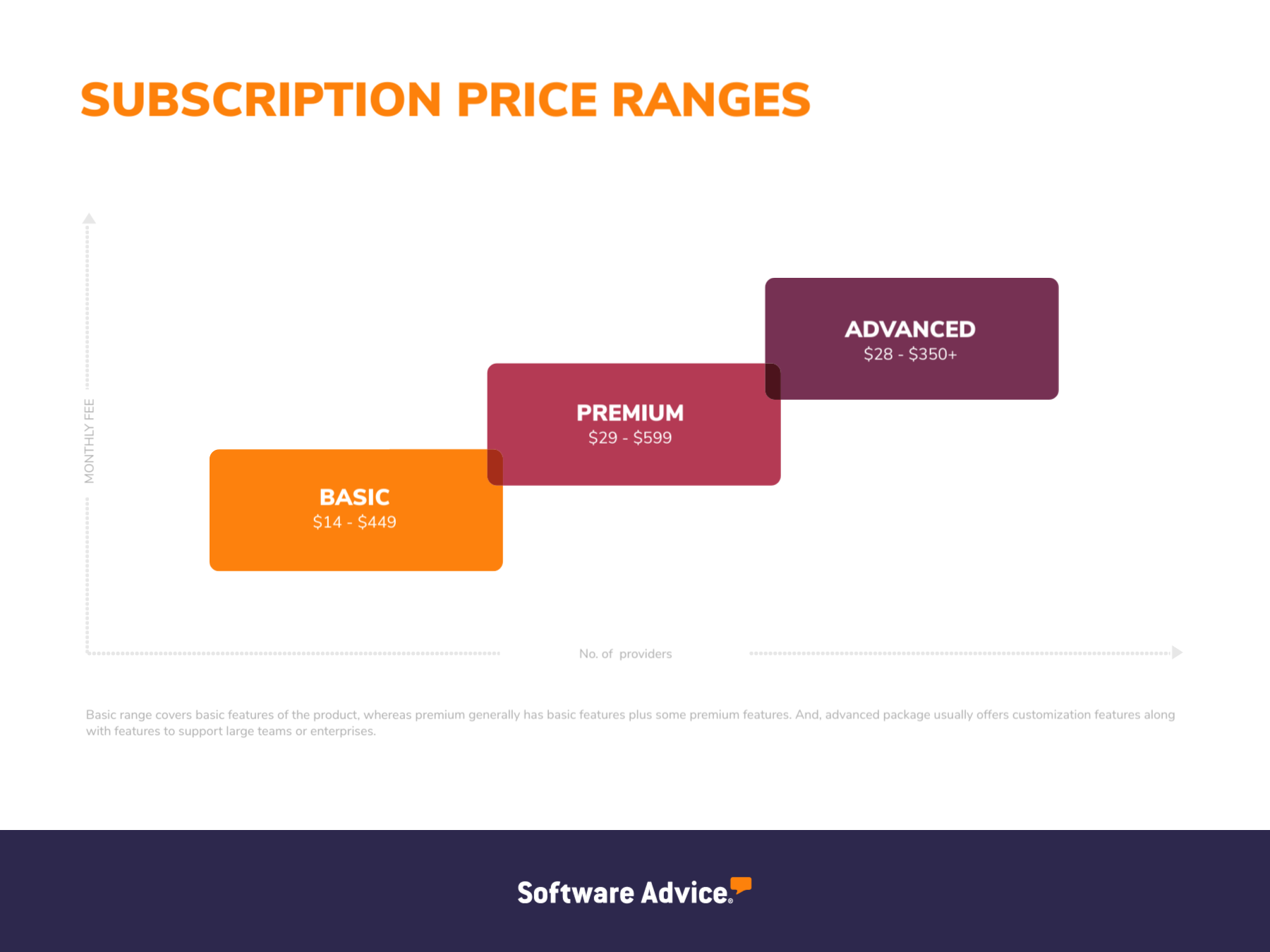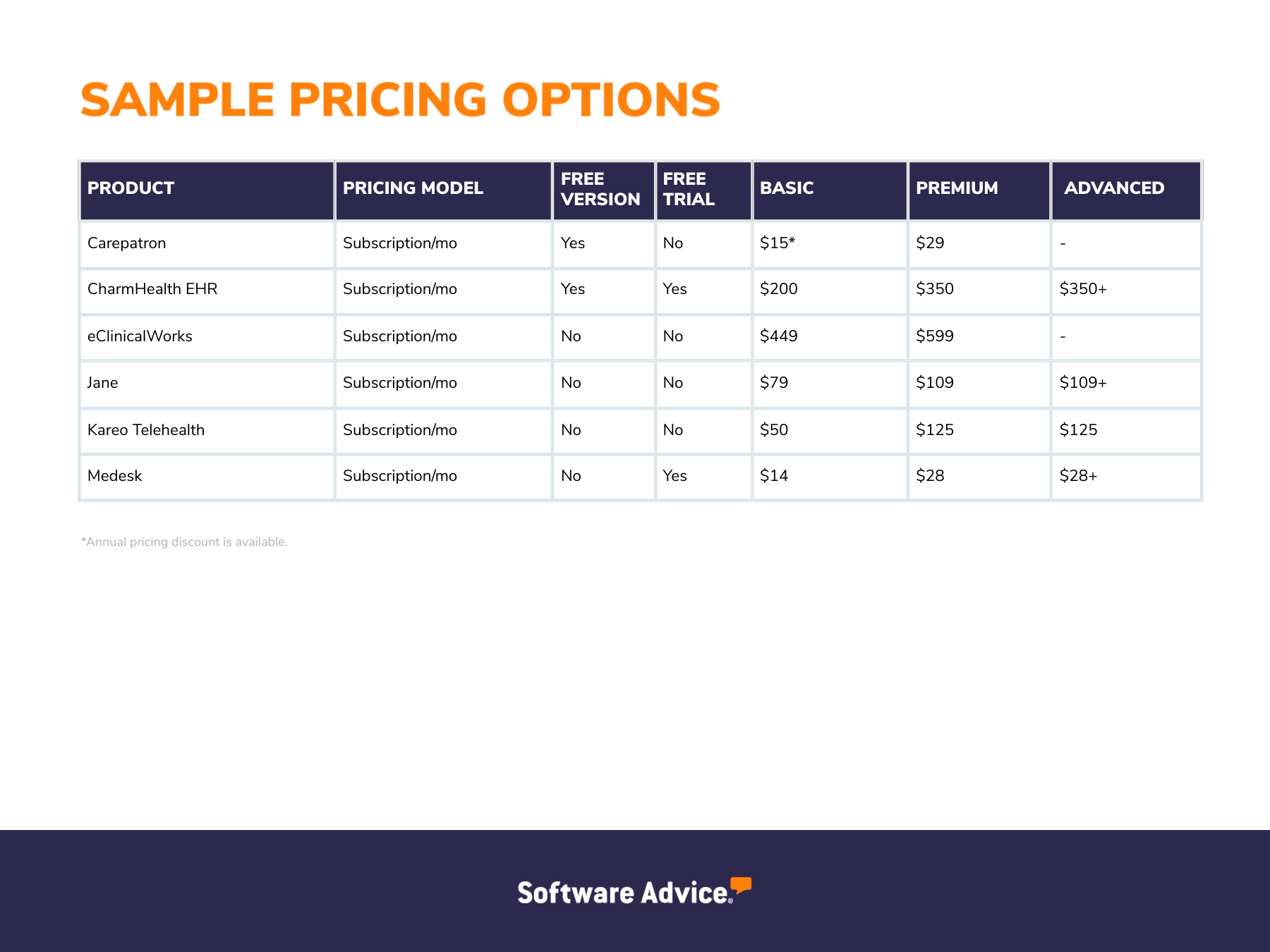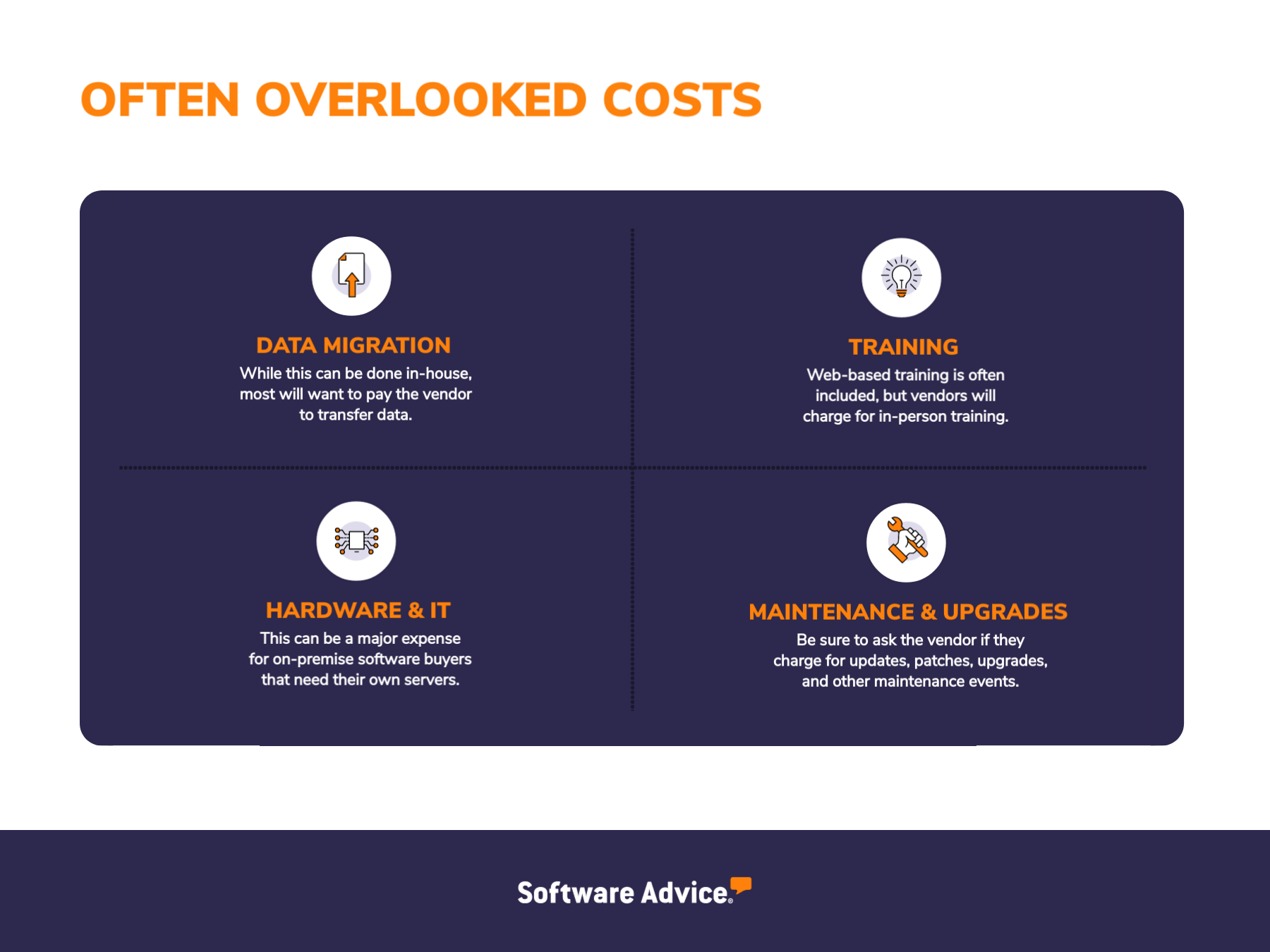Guide to Telemedicine Software Pricing Models
As a healthcare professional, if you’re considering providing virtual consultations or telehealth services to your patient, you can invest in telemedicine software. This type of software lets you connect with your patients over an audio or video conference, schedule appointments, and manage their medical records. However, before you pay for a telemedicine solution, ensure it fits your budget without compromising your business’s needs.
With that in mind, we’ve compiled this comprehensive pricing guide to help you compare the pricing of top-rated telemedicine software solutions. This will help you determine which plan will provide the most value for your investment and explain how much telemedicine tools cost.
How is telemedicine software priced?
Telemedicine software cost varies depending on factors such as software provider, features and functionalities offered, the number of supported users, and the business size.
Types of telemedicine software pricing models
The most common pricing model for telemedicine solutions is a subscription-based model. This model requires users to make monthly or annual payments to the software provider, as opposed to buying a one-time license.
Here are a few other common telemedicine software pricing models:
Freemium: A basic version of the software is free, with paid upgrades or add-ons for additional features.
Per user: Pricing is based on the number of software users.
One-time fee: Users pay a one-time fee to access the software and its features permanently.
Pay as you go: Users are charged based on usage (monthly/annually).
Some software providers also offer custom pricing plans or a combination of pricing models. Telemedicine platforms typically include three different pricing plans:
Basic: Starting at $14 per month, the basic plan includes limited telemedicine features and functionality, such as video conferencing and scheduling, but can be a good option for small medical clinics providing primary care.
Premium: Mid-range price category can cost from $29 to $599 per month. This pricing plan often includes more advanced features and capabilities, such as patient data management, HIPAA compliance, remote patient monitoring, and billing integrations.
Advanced: Ranging from $28 to $350+, catering to big healthcare organizations, and offering advanced features such as access via mobile app, reporting and analytics, and premium support and training.

For reference, below is a snapshot of the costs of some popular telemedicine software solutions.

A note on core features
Telemedicine software solutions enable healthcare providers to conduct remote consultations and deliver medical services to patients through secure audio or video conferencing, messaging, and data management tools. The core or basic functions of a telemedicine tool include appointment scheduling and remote treatment plans.
What are the upfront and recurring costs associated with telemedicine software?
The initial expenses incurred when purchasing or subscribing to the software are upfront costs. For example, the cost of a perpetual license, customization, installation, and integration. On the other hand, the ongoing expenses associated with using the software, such as subscription fees, premium customer support services, and maintenance costs, are called recurring costs. These costs may be charged on a monthly or annual basis and can also include the costs of upgrades or additional user licenses.
The upfront telemedicine software cost is incurred when purchasing or subscribing to the software. These costs include the price of the perpetual license, customization, installation, and integration. On the other hand, recurring cost is the cost paid on a monthly or annual basis. These costs include the ongoing expenses associated with using the software, such as subscription fees, premium customer support services, and maintenance costs.
Below are the upfront and recurring costs under the different telemedicine software pricing models.

Subscription license | Perpetual license | Free plans | |
|---|---|---|---|
What it is: | Monthly or annual fee to use the purchased solution. Typically, the number of users affects this type of pricing model. | One-time fee for a permanent license to use the telemedicine solution. The fee for the perpetual license can vary based on the number of users. | Basic telehealth software are free to use, allowing users to conduct basic telemedicine operations without having to incur any expense. |
Commonly used for: | Cloud-based deployments, where the system is hosted by vendors on their servers and can be accessed on compatible devices over the internet, such as smartphones and tablets. | On-premise deployments, where the system is hosted and maintained in-house on your own servers. | Individual healthcare providers or telemedicine startups with limited budgets and resources. |
Upfront costs: | Include installation, setup, and customization of the software. | One-time license fee, hardware (for example, servers) cost, and installation charges. | Installation or setup costs. |
Recurring costs: | A monthly or annual subscription fee per user and access to premium support offerings (e.g., 24/7 phone support hours and quick ticket response time). | Monthly, annual, or ad hoc maintenance (for example, updates, patches, and upgrades). Recurring costs may include premium support offerings (for example, extended phone support hours). | There are no recurring costs. You can use it freely, typically with limited features. |
Hidden costs: | Customization, implementation of unique company branding, and integration with existing software (such as payment gateways and accounting software). | Customization, integration, and IT staff overtime (or hiring more IT staff) to maintain servers. | Implementation, customization, maintenance, integration with existing tech stack, training, and premium support options. |
What are the additional fees associated with telemedicine software?
There can be some additional fees associated with telemedicine software that you may incur at the time of implementing the tool. This fee can increase your total cost of ownership. As these costs are common across different telemedicine software vendors and pricing models, you must budget for them in advance.

Data migration: Migrating to a new telemedicine system and transferring crucial data can be time-consuming and expensive. This may include increased expenditures for services, such as IT expert consultation, data organization, software setup, and data accuracy verification. It's crucial to assess the expenses associated with this data migration process and evaluate potential business downtime, along with its associated costs.
Training: The expenses associated with training for a new telemedicine system can fluctuate significantly, ranging from zero to several thousand dollars, depending upon the software's complexity. Several software providers provide complimentary online resources such as help desks, knowledge bases, FAQs, and instructional videos to minimize training expenditures. Engaging an implementation specialist to instruct your team and minimize downtime might be expense but can prove to be a valuable long-term investment.
Hardware and IT: The financial considerations associated with hardware and IT in a telemedicine solution encompass acquiring or enhancing servers for software hosting, upgrading employee workstations or mobile devices to meet the system's technical prerequisites, and potentially enlisting IT professionals for seamless technology maintenance. These expenses can add up on top of the telemedicine software costs. Therefore, it's vital to evaluate whether the software implementation will include any additional costs or infrastructure improvements before finalizing your decision.
Maintenance and upgrades: Maintenance fees refer to the expenditures linked to the upkeep of a telemedicine system, ensuring its uninterrupted operation and alignment with the most recent functionalities. These recurrent costs occur periodically and can accrue as time goes on. It's crucial to ascertain whether the vendor incorporates maintenance and upgrade services within your software subscription or licensing charges. Alternatively, you may opt for an in-house team to handle maintenance and support responsibilities.
How to find the right telemedicine price range
Assess your telemedicine needs. Create a list of key features and functionalities you require from telemedicine software. This may include video conferencing, patient record management, e-prescribing, billing, scheduling, and security features. Your requirements will vary depending on the type of healthcare services you offer.
Consider scalability. Think about your clinic’s growth potential before finalizing a pricing plan. Ensure the telemedicine software can scale with your needs as your medical practice grows and you have more patient data to manage. Consider a solution that can manage an increased user base and data without a significant increase in cost.
Evaluate contract terms. Pay attention to contract terms and commitment periods. Some providers may require long-term contracts, while others may offer more flexibility. Choose an option that aligns with your business's stability and growth plans.
Common questions to ask when choosing telemedicine software
Does the tool have a free trial or demo version?
A free telemedicine software trial will allow you to test the platform's compatibility with your specific needs, evaluate its ease of use, and assess the quality of its features. It will provide a firsthand opportunity to experience the user interface, patient and provider experience, and support services. This trial period will help you determine if the software aligns with your workflow, ensuring a more informed decision and preventing costly investments in a tool that may not meet your requirements.
Is there an open source version of the software?
Exploring open source telemedicine software offers a chance to assess the tool’s customization, flexibility, and cost-efficiency. Open-source solutions provide access to the software's source code, enabling you to tailor it to your specific needs and integrate it with existing systems. It can also be a cost-effective option with no licensing fees. Considering open source alternatives will give you greater control over your telemedicine tool, potentially saving on expenses and ensuring a solution that perfectly aligns with your unique requirements.
Are there any add-on functionalities?
Add-on functionalities of telemedicine software can significantly enhance the software's capabilities, simplifying processes and improving patient care. Assessing whether the software offers add-ons such as Electronic Medical Records (EMR) software integration, remote monitoring, e-prescribing, and secure messaging will help you customize the solution. These functionalities can impact the efficiency and effectiveness of telemedicine services, allowing you to maximize the software's utility in delivering healthcare services.
Find the best telemedicine packages
Do the telemedicine tools listed in this guide fall within your software budget? If so, compare their features and read real user reviews of more than 1,000 similar products listed on our telemedicine category page.
Sources
The products in this guide qualified for the most recent FrontRunners for telemedicine and were highly rated by users. Only products with publicly available pricing information were included in this table. We summarized publicly available pricing sources, including vendor websites as of September 2023, beginning with the lowest monthly pricing (not including annual discounts) for packages that include the core functionality for a software category. We list pricing for more advanced packages (per user, when available) that include the core software feature(s). Your company’s needs may differ, and final pricing may vary.
Note: This article is intended to inform our readers about business-related concerns in the U.S. It is in no way intended to provide financial advice or to endorse a specific course of action. For advice on your specific situation, consult your accountant or financial consultant.